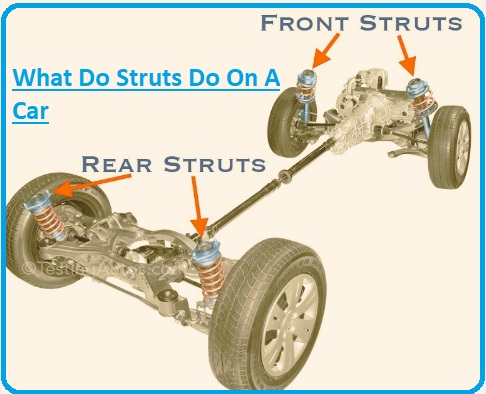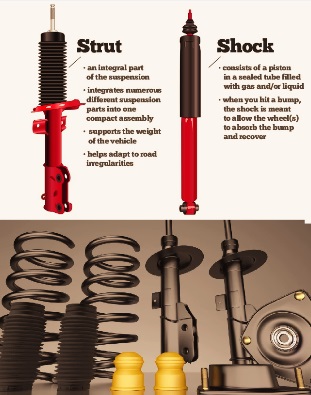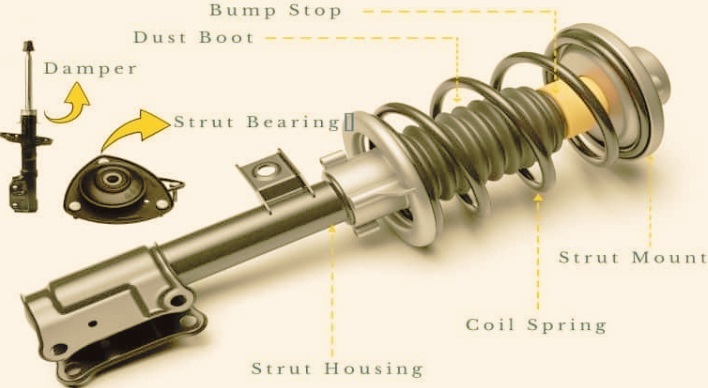Struts of a car are the main part of the suspension system of vehicles, whose function is to make a connection between the tire or wheel and the body of the car. It exists on the chassis at the front side of front-wheel-drive automobiles. But they do not only exist on front-wheel-drive vehicles since their main function is to manage vehicle weight through observing the impact of the surface and providing an easy ride without any hindrances.
What is car struts of car?
Struts’ main function is to control and manage dampened vibrations of the car. This place has a spring and pump system that has a spring and shock absorber for damping purposes.
The strut belongs to the independent suspension system, where the piston is connected with the piston rod through operating against hydraulic fluid; it controls the spring of the vehicle and suspension movement.
Struts operate like valves that control resistance through suspension motion.
Strut housings provide structural support to the assembly and damping components that regulate spring and suspension movement.
The lower part of the scratch connected with his steering knuckle, which is configured with a lower ball joint to the lower control arm.
Struts Working
The main operation of struts is to provide stability during driving when we apply the brake or accelerate, and moving on any uneven road provides stability to the driver and passenger.
Accurate working of struts provides low bouncing of the vehicle during driving; if they do not work well, they provide nonuniform driving and affect passengers.
So, for a long drive or moving on rough roads, make sure the car struts are working well without any fault.
Importance of Struts in Cars
It is necessary that the suspension system of the car must connect struts in proper working order since they provide smooth, easy, and good performance of your vehicle in any conditions. Some important points that show the importance of tracks for your car:
Even Tire Wear
If you have damaged or worn-out struts, it causes uneven tire wear, but if the struts are working in proper condition, they produce tire wear and provide a strong grip during driving on the road. They also increase the working life of the tire and provide safe driving.
Control and Stability
During driving, everyone wants safe and stable driving during a long drive or on a rough road. Your car’s struts easily manage bumps during driving; if they are working accurately, they also provide stability and accurate handling during sharp turns and in hill areas.
Handling and Safety of the car
For the safety of your car, proper handling during driving is an important factor. That can be gotten through the accurate working of struts. Since they provide easy moving and stability during rough and bumpy roads, and easily stop the vehicle when required.
But if struts are not working well, they can cause improper handling and have a chance of any incident or make your drive unsure and bad.
Comfortable Traveling
Your traveling can be comfortable and pleasant through proper working of struts since they easily reduce bumps and vibration that occur during driving on nonuniform and rough roads.
Struts are the main part of our car suspension system that make over-travelling and long drives safe and sound since they manage all hardships and conditions that can cause unstable travelling.
Struts vs. Shocks
- The main difference between struts and shocks is that a strut exists as the main component of the vehicle suspension system, and a shock is not a component of the suspension system.
- The strut also belongs to the car’s steering system and affects angle alignment.
- On vertical position, caster and camber regulated themselves. With that strut comes a coil spring, and it works as a pivot point in the vehicle’s steering system.
- Struts are important but cost more than shocks.
- The main function of a shock absorber is to control vehicle bouncing during driving. Struts operate in the suspension system and exist on the chassis of your vehicle.
- It helps to connect the coil spring, which controls vehicle height. For this purpose, the plate connects here for the spring.
- Either the starting cost of struts is low, or shock absorbers have good handling features.
| Feature | Struts | Shocks (Shock Absorbers) |
| Function | Structural component of the suspension and steering system | Controls bounce; not a structural part of the suspension system |
| Placement | connected to the chassis at the top and makes a connection to the knuckle; includes a spring seat | exists between suspension and frame/body |
| Contains Spring | Yes, contains a coil spring | No |
| Alignment Impact | Affects alignment (camber and caster adjusted on strut) | not affect alignment |
| Steering Role | main component for the steering system; used as a pivot point | Not part of the steering system |
| Cost | expensive | Less expensive |
| Handling vs. Cost | lower initial vehicle cost | Provides good handling |
| Replacement Requirement | Requires alignment after replacement | No alignment needed |
| Replacement Difficulty | complex; needed a spring compressor | Easier to replace |
| Inspection Method | Bounce test and check for oil leaks; replace in pairs | like struts |
| Safety Warning | Dangerous due to high spring tension; must use spring compressor | safe with basic tools |
Components of a Strut
There are different parts of struts, and each has its own function.
Coil Spring
- Coil springs wound over the strut operate like a shock absorber for managing the height and weight of the vehicle. This spring, like others, provides compression and expansion for absorbing vibrations and other road hurdles.
Shock Absorber
- This part of the strut is used for absorbing and controlling vibrations to minimize bouncing factors. The shock absorber dampens impact energy and provides a stable working environment.
Strut Housing
- strut housing cover inner structure. In this way, it gives support to the structure and protects other structural parts like the shock absorber and coil spring.
- housing directly connected between the suspension and the car frame
Bearing Plate
- • A bearing plate exists on the upper side of the strut, which causes uniform suspending motion. In this way, the strut moves with the steering system, minimizing friction for fast turn operations.
Piston and Rods
- Pistons and rod work combine to move hydraulic fluid in the shock absorber that dampens suspension motion. These parts also control upward and downward motion in fluid, giving resistance for oscillations and force for shock absorption.
Spring Seat:
- • The spring seat gives accurate position and control to the coil spring and fixes it at a certain point. It operates with a combination of bearing plates for transferring the load to the chassis easily.
Why Strut used in Car’s Suspension System
The main working of the suspension system is to make a proper connection of the vehicle tires to the road for uniform riding. Struts exist in the suspension system of cars for some important functions that are
Vehicle’s Weight Support
- strut provides support to the car’s weight and distributes the weight smoothly over the wheels. The strut design comes with a spring, which holds the car, and the absorber prevents the car from bouncing.
Dampens Shocks
- When a car moves on rough roads and faces bumps and potholes, struts easily absorb shocks and impact. The shock absorber, as part of the strut, helps to provide smooth driving without affecting road bumps. If struts are not working, car driving is affected on rough surfaces and can cause damage.
Stable Steering
- Struts also provide easy steering and stable turning. It aligns wheels and makes a strong connection between the car wheels and the road.
- If struts not function well, they affect handling, like bad wheel alignment and difficult car control during turns.
Signs of Bad Struts
Struts have a working life and get damaged after some time. So there are some signs that indicate your strut is falling and needs replacement.
Rough Ride
- The common sign of damaged struts is that your drive on a bouncy road clearly bounces. If the car is highly striking with bumps on rough roads, there is a chance that the struts need to be replaced with new ones.
Tire Wear
- Damaged struts cause uneven tire wear. If struts make tires connected with the road, it causes uneven wear. that causes a rough ride and affects road grip, and is difficult to drive
Weak Steering or Handling
- Difficult steering also affects stability, and when taking turns, it causes instability; that is a sign the strut is damaged and not working. Damaged struts make the car feel floaty.
How Long Do Struts Last?
- Normally, struts’ working life is 50000 to 100000 miles, working life based on driving roads, conditions, and the manufacturers of struts.
- Rough road driving or heavy loads on the vehicle affect struts in a short time.
- Best is to regularly inspect struts and replace if needed. Regular inspection of the vehicle suspension system and maintenance increases the working life of struts.
Front Struts vs. Rear Struts
- Front struts are connected at the front suspension, and rear struts exist on the backside of the car. Each has its own working and uses. Front struts are commonly used since they connect to the steering to provide control. The main feature of front struts is to increase the car’s front weight, and accurate handling is needed.
- But rear struts are not very common to use, but are mostly used in racing cars since they provide high stability and handling.
- Rear struts also absorb vibrations of the back wheels for load distribution.
- Front struts are the main function for steering and braking, and rear struts increase balance. In networking, provide control and stability for safe driving.
How Much Do Struts Cost?
- Struts are costly to replace since they come in pairs, so if either one is damaged, replace both.
- So their cost per strut is 350 to 800 dollars on the front side and 300 to 600 dollars on the rear for a single strut.
- Strut replacement: Take some time, around 3 hours, for professional work.
FAQs
How many struts does my car have?
- number of struts based on vehicle suspension design and features. Some cars have two struts for the front suspension. Some types with independent rear suspension needed 4 rear struts.
Are Struts and Shocks the Same?
- It is found not all vehicles have struts. Some vehicles come with absorbers, and some have shock absorbers on the front and back wheels or have struts, or vice versa.
- In features, shocks and struts look the same but are not the same, so they are also not replaced interchangeably.
- Shocks are different parts that do not belong to the suspension; they provide damping for the suspension, like struts, not structural support.
- While struts perform damping and structural support.
Where are the locations of the struts on the car?
- Normally, car struts exist on the front suspension, connected to the steering system. Sports cars and high-performance cars also have struts on the rear suspension for easy driving.
Can we drive with bad struts?
- Driving a car with damaged struts causes bad steering handling, difficult braking, tire wear, and an uncomfortable driving experience. It also affects steering control.








